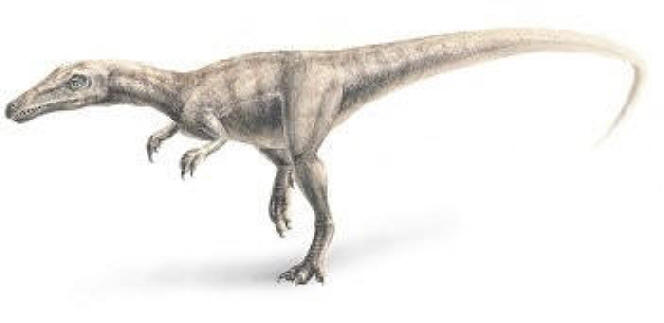REUTERS / Stephanie Abromowicz An undated handout image shows an
artist's impression of how a newly discovered dinosaur, called
Juraventor, might look after a perfectly preserved fossil of a 150
million-year-old dinosaur was found in southern Germany.
NEW YORK -- A
beautifully preserved fossil from southern Germany raises questions
about how feathers evolved from dinosaurs to birds, two
paleontologists argue in a study published Thursday. The 150 million-year-old fossil is a juvenile carnivorous dinosaur
about 2˝ feet long that scientists named Juravenator, for the Jura
mountains where it was found. It would have looked similar in life to the fleet-footed predators
that menaced a young girl on the beach during the opening scene of
“The Lost World,” the second Jurassic Park movie.
The fossil's exceptionally well-preserved bone structure clearly
puts it among feathered kin on the dinosaur family tree. Because all
of its close relatives are feathered, paleontologists would expect
Juravenator to follow suit. But a small patch of skin on the creature's tail shows no sign of
feathers. And the skin also doesn't have the follicles that are
typical of feathered dinosaurs, said Luis Chiappe, director of the
Dinosaur Institute at the Natural History Museum of Los Angeles
County. He and Ursula B. Gohlich of the University of Munich describe
the fossil in Thursday's issue of the journal Nature. “It has a typical scaly dinosaurian skin,” Chiappe said.
The paleontologists believe Juravenator's closest known relative
may have been a fully feathered dinosaur from China, Sinosauropterix. There are a number of possible explanations for Juravenator's
nakedness. Feathers could have been lost on the evolutionary line
leading to Juravenator after arising in an ancestor to both it and its
feathered relatives. Or feathers could have evolved more than once in
dinosaurs, cropping up in sister species at different times and
places. It is also possible that this particular fossil of Juravenator,
which appears to be a juvenile, only grew feathers as an adult or lost
its feathers for part of the year. But there is another possibility as well, said Mark Norell, curator
of paleontology at the American Museum of Natural History: It is
entirely possible that Juravenator did have feathers, but they simply
failed to fossilize. “Feathers are really just difficult things to preserve,” Norell
said.
To support his hypothesis he pointed out that several fossils of
the oldest known bird, archaeopteryx, lack feathers. Whether or not the new specimen raises interesting questions about
how feathers -- and thus birds -- evolved, most experts do not see it
as a challenge to the widely accepted view that modern birds are
descended from dinosaurs. |
![]()
